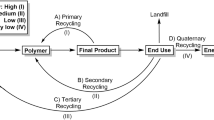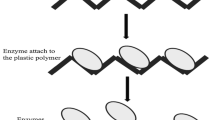Abstract
The petrochemical industry is responsible for many accidental releases of pollutants in soil such as hydrocarbons and toxic metals. This co-contamination is responsible for a delay in the degradation of the organic pollution. Many successful technologies to remove these metals apply extracellular polymeric substances (EPS). In this study, we tested the application of an EPS from a Paenibacillus sp. to aid the bioremediation of soils contaminated with crude oil and nickel. We conducted a microcosm experiment to soils containing combinations of oil, nickel, and EPS. The final concentration of oil was evaluated with an infrared spectrometer. Also, we sequenced the metagenomes of the samples in an ion torrent sequencer. The application of EPS did not aid the removal of hydrocarbons with or without the presence of nickel. However, it led to a smaller decrease in the diversity indexes. EPS decreased the abundance of Actinobacteria and increased that of Proteobacteria. The EPS also decreased the connectivity among Actinobacteria in the network analysis. The results indicated that the addition of EPS had a higher effect on the community structure than nickel. Altogether, our results indicate that this approach did not aid the bioremediation of hydrocarbons likely due to its effect in the community structure that affected hydrocarbonoclastic microorganisms.







Similar content being viewed by others
References
Hill EC (1984) Biodegradation of petroleum products. In: Atlas RM (ed) 2nd ed. McMillan Publishing Co, New York, pp 579–612
Ambituuni A, Amezaga JM, Werner D (2015) Risk assessment of petroleum product transportation by road: a framework for regulatory improvement. Saf Sci 79:324–335. https://doi.org/10.1016/j.ssci.2015.06.022
Taketani NF, Taketani RG, Leite SGF, de Lima Rizzo AC, Tsai SM, da Cunha CD (2015) The influence of nickel on the bioremediation of multi-component contaminated tropical soil: microcosm and batch bioreactor studies. World J Microbiol Biotechnol 31(7):1127–1135. https://doi.org/10.1007/s11274-015-1862-x
Mason OU, Scott NM, Gonzalez A, Robbins-Pianka A, Bælum J, Kimbrel J, Bouskill NJ, Prestat E, Borglin S, Joyner DC, Fortney JL, Jurelevicius D, Stringfellow WT, Alvarez-Cohen L, Hazen TC, Knight R, Gilbert JA, Jansson JK (2014) Metagenomics reveals sediment microbial community response to Deepwater Horizon oil spill. ISME J 8(7):1464–1475. https://doi.org/10.1038/ismej.2013.254
Dermont G, Bergeron M, Mercier G, Richer-Laflèche M (2008) Metal-contaminated soils: remediation practices and treatment technologies. Pract Period Hazard Toxic, Radioact Waste Manag 12(3):188–209. https://doi.org/10.1061/(ASCE)1090-025X(2008)12:3(188)
Singh AK, Cameotra SS (2013) Efficiency of lipopeptide biosurfactants in removal of petroleum hydrocarbons and heavy metals from contaminated soil. Environ Sci Pollut Res 20(10):7367–7376. https://doi.org/10.1007/s11356-013-1752-4
Decho AW, Gutierrez T (2017) Microbial extracellular polymeric substances (EPSs) in ocean systems. Front Microbiol 8(MAY):1–28. https://doi.org/10.3389/fmicb.2017.00922
Omoike A, Chorover J (2006) Adsorption to goethite of extracellular polymeric substances from Bacillus subtilis. Geochim Cosmochim Acta 70(4):827–838. https://doi.org/10.1016/j.gca.2005.10.012
Bhaskar PV, Bhosle NB (2006) Bacterial extracellular polymeric substance (EPS): a carrier of heavy metals in the marine food-chain. Environ Int 32(2):191–198. https://doi.org/10.1016/j.envint.2005.08.010
Guiné V, Martins JMF, Causse B, Durand A, Gaudet JP, Spadini L (2007) Effect of cultivation and experimental conditions on the surface reactivity of the metal-resistant bacteria Cupriavidus metallidurans CH34 to protons, cadmium and zinc. Chem Geol 236(3-4):266–280. https://doi.org/10.1016/j.chemgeo.2006.10.001
Johnson KJ, Cygan RT, Fein JB (2006) Molecular simulations of metal adsorption to bacterial surfaces. Geochim Cosmochim Acta 70(20):5075–5088. https://doi.org/10.1016/j.gca.2006.07.028
Lamelas C, Benedetti M, Wilkinson KJ, Slaveykova VI (2006) Characterization of H+ and Cd2+ binding properties of the bacterial exopolysaccharides. Chemosphere 65(8):1362–1370. https://doi.org/10.1016/j.chemosphere.2006.04.021
Cui D, Tan C, Deng H, Gu X, Pi S, Chen T, Zhou L, Li A (2020) Biosorption mechanism of aqueous Pb2+, Cd2+, and Ni2+ions on extracellular polymeric substances (EPS). Archaea 2020:8891543. https://doi.org/10.1155/2020/8891543
Volesky B (1990) Removal and recovery of heavy metals by biosorption. In: Volesky B (ed) Biosorption of heavy metals. CRC Press, Boca Raton, pp 7–44
Volesky B, Holan ZR (1995) Biosorption of heavy metals. Biotechnol Prog 11(3):235–250. https://doi.org/10.1021/bp00033a001
Kratochvil D, Volesky B (1998) Advances in the biosorption of heavy metals. Trends Biotechnol 16(7):291–300. https://doi.org/10.1016/S0167-7799(98)01218-9
Ledin M, Pedersen K (1996) The environmental impact of mine wastes-roles of microorganisms and their significance in treatment of mine wastes. Earth-Sci Rev 41(1-2):67–108. https://doi.org/10.1016/0012-8252(96)00016-5
Rittmann BE, Hausner M, Loffler F et al (2006) A vista for microbial ecology and environmental biotechnology. Environ Sci Technol 40(4):1096–1103
Weaver PF, Wall JD, Gest H (1975) Characterization of Rhodopseudomonas capsulata. Arch Microbiol 105(1):207–216
Taketani NF, Taketani RG, Leite SGF, Melo IS, Lima-Rizzo AC, Andreote FD, Cunha CD (2020) Effect of nickel in the degradation of oil in soils contaminated with petroleum and nickel. Int J Adv Eng Res Sci 7(7):511–521. https://doi.org/10.22161/ijaers.77.58
Taketani RG, Moitinho MA, Mauchline TH, Melo IS (2018) Co-occurrence patterns of litter decomposing communities in mangroves indicate a robust community resistant to disturbances. PeerJ. 6:e5710. https://doi.org/10.7717/peerj.5710
Meyer F, Paarmann D, D’Souza M et al (2008) The metagenomics RAST server–a public resource for the automatic phylogenetic and functional analysis of metagenomes. BMC Bioinform 9(1):386. https://doi.org/10.1186/1471-2105-9-386
Delmont TO, Malandain C, Prestat E et al (2011) Metagenomic mining for microbiologists. ISME J 5:1837–1843. https://doi.org/10.1038/ismej.2011.61
Mcmurdie PJ, Holmes S (2013) phyloseq: an R package for reproducible interactive analysis and graphics of microbiome census data. 8(4):e61217. https://doi.org/10.1371/journal.pone.0061217
Lahti L, Shetty S, Blake T, Salojarvi J. microbiome R package.
Wickham H (2009) Ggplot2: elegant graphics for data analysis. Springer, New York. http://had.co.nz/ggplot2/book
Oksanen J, Blanchet FG, Friendly M et al (2019) vegan: community ecology package. 2.5-6. https://CRAN.R-project.org/package=vegan
Kursa MB (2010) Feature selection with the Boruta package. J Stat Softw 36(11):i11
Warnes GR, Bolker B, Bonebakker L et al (2020) gplots: various R programming tools for plotting data. 3.1.0. https://CRAN.R-project.org/package=gplots
Kurtz ZD, Müller CL, Miraldi ER, Littman DR, Blaser MJ, Bonneau RA (2015) Sparse and compositionally robust inference of microbial ecological networks. PLoS Comput Biol 11(5):1–25. https://doi.org/10.1371/journal.pcbi.1004226
Csárdi G, Nepusz T (2006) The igraph software package for complex network research. InterJournal Complex Syst 1695:1695
Epskamp S, Cramer AOJ, Waldorp LJ, Schmittmann VD, Borsboom D (2012) {qgraph}: network visualizations of relationships in psychometric data. J Stat Softw 48(4):1–18. http://www.jstatsoft.org/v48/i04/
Bastian M, Heymann S, Jacomy M (2009) Gephi: an open source software for exploring and manipulating networks. http://www.aaai.org/ocs/index.php/ICWSM/09/paper/view/154
Rittmann BE (2006) Microbial ecology to manage processes in environmental biotechnology. Trends Biotechnol 24(6):261–266. https://doi.org/10.1016/j.tibtech.2006.04.003
da Cunha CD, Taketani NF, de Lima Rizzo AC, Leite SGF (2017) Produção de EPS e sua aplicação na sorção de metais.
Paul A, Pal AK (2008) Microbial extracellular polymeric substances: central elements in heavy metal bioremediation. Indian J Microbiol 48(March):49–64
Arnosti C, Ziervogel K, Yang T, Teske A (2016) Oil-derived marine aggregates-hot spots of polysaccharide degradation by specialized bacterial communities. Deep Res Part II Top Stud Oceanogr 129:179–186. https://doi.org/10.1016/j.dsr2.2014.12.008
Bodelier PLE (2011) Toward understanding, managing, and protecting microbial ecosystems. Front Microbiol 2(April):1–8. https://doi.org/10.3389/fmicb.2011.00080
Curiel Yuste J, Fernandez-Gonzalez AJ, Fernandez-Lopez M, Ogaya R, Penuelas J, Sardans J, Lloret F (2013) Strong functional stability of soil microbial communities under semiarid Mediterranean conditions and subjected to long-term shifts in baseline precipitation. Soil Biol Biochem 69(November):1–11. https://doi.org/10.1016/j.soilbio.2013.10.045
Taketani RG, Kavamura VN, Mendes R, Melo IS (2014) Functional congruence of rhizosphere microbial communities associated to leguminous tree from Brazilian semiarid region. Environ Microbiol Rep 7:95–101. https://doi.org/10.1111/1758-2229.12187
Varjani SJ (2017) Microbial degradation of petroleum hydrocarbons. Bioresour Technol 223:277–286. https://doi.org/10.1016/j.biortech.2016.10.037
Salwan R, Sharma V (2018) The role of Actinobacteria in the production of industrial enzymes. Elsevier B.V. https://doi.org/10.1016/B978-0-444-63994-3.00011-4
Zhang B, Pi Y, Cai Q et al (2017) Microbial degradation of four crude oil by biosurfactant producing strain Rhodococcus sp. Bioresour Technol 232:263–269. https://doi.org/10.1016/j.biortech.2017.02.007
Bacosa HP, Kamalanathan M, Chiu MH, Tsai SM, Sun L, Labonté JM, Schwehr KA, Hala D, Santschi PH, Chin WC, Quigg A (2018) Extracellular polymeric substances (EPS) producing and oil degrading bacteria isolated from the northern Gulf of Mexico. PLoS One 13(12):1–19. https://doi.org/10.1371/journal.pone.0208406
Kavamura VN, Santos SN, Da Silva JL et al (2012) Screening of Brazilian cacti rhizobacteria for plant growth promotion under drought. Microbiol Res. https://doi.org/10.1016/j.micres.2012.12.002
Albertsen M, Stensballe A, Nielsen KL, Nielsen PH (2013) Digging into the extracellular matrix of a complex microbial community using a combined metagenomic and metaproteomic approach. Water Sci Technol 67(7):1650–1656. https://doi.org/10.2166/wst.2013.030
Moitinho MA, Bononi L, Souza DT, Melo IS, Taketani RG (2018) Bacterial succession decreases network complexity during plant material decomposition in mangroves. Microb Ecol 76:954–963. https://doi.org/10.1007/s00248-018-1190-4
Author information
Authors and Affiliations
Corresponding authors
Ethics declarations
This article does not contain any studies with human participants or animals performed by any of the authors.
Conflict of interest
The authors declare that they have no conflict of interest.
Additional information
Responsible Editor: LUCY SELDIN
Publisher’s note
Springer Nature remains neutral with regard to jurisdictional claims in published maps and institutional affiliations.
Supplementary information
ESM 1
(PDF 920 kb)
Rights and permissions
About this article
Cite this article
Taketani, N.F., Taketani, R.G., Leite, S.G.F. et al. Application of extracellular polymers on soil communities exposed to oil and nickel contamination. Braz J Microbiol 52, 651–661 (2021). https://doi.org/10.1007/s42770-021-00428-z
Received:
Accepted:
Published:
Issue Date:
DOI: https://doi.org/10.1007/s42770-021-00428-z




